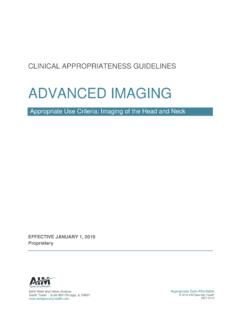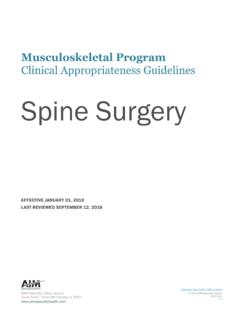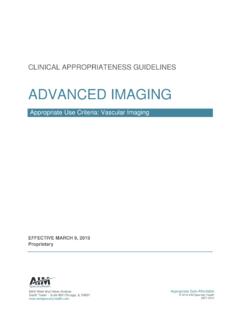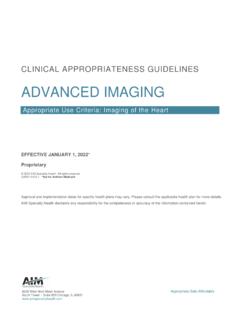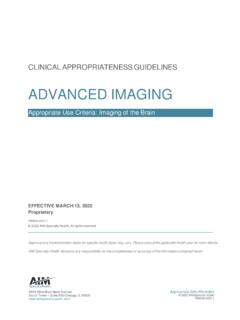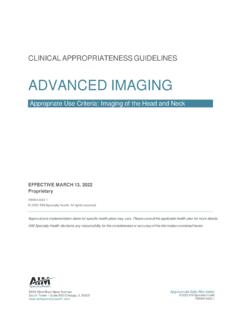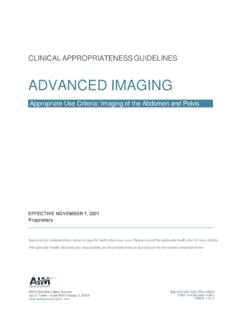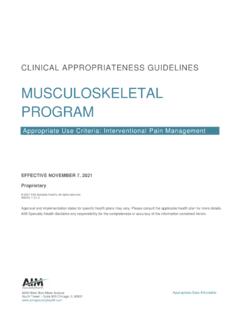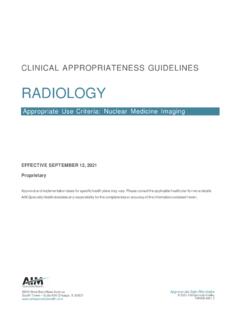Transcription of ADVANCED IMAGING - AIM Specialty Health
1 8600 West Bryn Mawr Avenue South Tower Suite 800 Chicago, IL 60631 2017 CLINICAL APPROPRIATENESS GUIDELINES ADVANCED IMAGING Appropriate Use Criteria: IMAGING of the Extremities EFFECTIVE SEPTEMBER 12, 2021 Proprietary 2021 AIM Specialty Health Approval and implementation dates for specific Health plans may vary. Please consult the applicable Health plan for more details. AIM Specialty Health disclaims any responsibility for the completeness or accuracy of the information contained herein.
2 IMAGING of the Extremities 2021 AI M Specialty Health . All rights reserved. 2 Table of Contents Table of Contents .. 2 Description and Appli cation of the 4 General Clini cal 5 Clinical Approp riateness Framework .. 5 Simultaneous Ordering of Multiple Diagnostic or Therapeutic Interventions .. 5 Repeat Diagnostic Intervention .. 5 Repeat Therapeutic Intervention .. 6 IMAGING of the Extremities .. 7 General Information/Overview .. 7 Scope .. 7 Technology Considerations .. 7 Definitions .. 7 Clinical 9 Congenital and Developmental Conditions.
3 10 Congenital or developmental anomalies of the extremity (Pediatric only) .. 10 Tarsal coalition .. 10 10 Soft tissue infection .. 10 Osteomyelitis or septic 11 Inflammatory Conditions .. 11 Capitellar 11 Juvenile idiopathic arthritis (Pediatric only).. 11 Myositis .. 12 Plantar fasciitis and fibromatosis .. 12 13 13 Traumatic injuries acute/not otherwise 14 14 Brachial plexus mass .. 14 Indeterminate bone 14 Morton s neuroma .. 15 Pigmented villonodular synovitis .. 15 Soft tissue mass not otherwise specified.
4 15 Ligament and Tendon Derangement of the Upper Extremity .. 16 Adhesive capsulitis (Adult only).. 16 Labral tear shoulder .. 16 Ligament and tendon injuries upper extremity, not listed elsewhere .. 17 Rotator cuff 17 Tendon rupture biceps or 18 Triangular fibrocartilage complex 18 Ulnar collateral ligament tear (elbow or thumb).. 19 IMAGING of the Extremities 2021 AI M Specialty Health . All rights reserved. 3 Ligament and Tendon Derangement of the Lower Extremity .. 19 Labral tear and femoral acetabular impingement 19 Ligament tear knee.
5 20 Ligament and tendon injury and rupture foot and ankle .. 20 Lisfranc 20 Meniscal tear/injury .. 20 Miscel laneous Conditions .. 21 Avascular necrosis .. 21 Chronic anterior knee pain (including chondromalacia patella and patellofemoral pain syndrome) .. 22 Hemarthrosis .. 22 Intra-articular loose body .. 22 Legg-Calve-Perthes disease (Pediatric only) .. 23 Osteochondral lesion (including osteochondritis dissecans, transient dislocation of patella).. 23 Paget disease .. 23 Slipped capital femoral epiphysis (Pediatric only).
6 23 Neurogenic Conditions .. 24 Brachial plexopathy .. 24 Entrapment neuropathy (excluding carpal and cubital tunnel) .. 24 Neuropathic osteoarthropathy (Charcot joint) (Adult only).. 24 Tarsal tunnel .. 24 Pain, unspecified .. 24 Non-specific hip pain, including limping child (Pediatric only) .. 24 Lower extremity pain, not otherwise specified .. 25 Upper extremity pain, not otherwise specified .. 25 Perioperative IMAGING , unspecified .. 25 Reverse shoulder 25 Knee arthroplasty, presurgical 26 Perioperative IMAGING (including delayed hardware failure), not otherwise 27 References.
7 27 Codes .. 30 History .. 31 IMAGING of the Extremities 2021 AI M Specialty Health . All rights reserved. 4 Description and Application of the Guidelines The AIM Clinical Appropriateness Guidelines (hereinafter the AIM Clinical Appropriateness Guidelines or the Guidelines ) are designed to assist providers in making the most appropriate treatment decision for a specific clinical condition for an individual. As used by AIM, the Guidelines establish objective and evidence-based criteria f or medical necessity determinations where possible.
8 In the process, multiple functions are accomplished: To establish criteria for when services are medically necessary To assist the practitioner as an educational tool To encourage standardization of medical practice patterns To curtail the performance of inappropriate and/or duplicate services To advocate for patient safety concerns To enhance the quality of Health care To promote the most efficient and cost-effective use of services The AIM guideline development process complies with applicable accreditation standards.
9 Including the requirement that the Guidelines be developed with involvement from appropriate providers with current clinical expertise relevant to the Guidelines under review and be based on the most up-to-date clinical principles and best practices. Relevant citations are included in the References section attached to each Guideline. AIM reviews all of its Guidelines at least annually. AIM makes its Guidelines publicly available on its website twenty-four hours a day, seven days a week. Copies of the AIM Clinical Appropriateness Guidelines are also available upon oral or written request.
10 Although the Guidelines are publicly-available, AIM considers the Guidelines to be important, proprietary information of AIM, which cannot be sold, assigned, leased, licensed, reproduced or distributed without the written consent of AIM. AIM applies objective and evidence-based criteria, and takes individual circumstances and the local delivery system into account when determining the medical appropriateness of Health care services. The AIM Guidelines are just guidelines for the provision of Specialty Health services.
